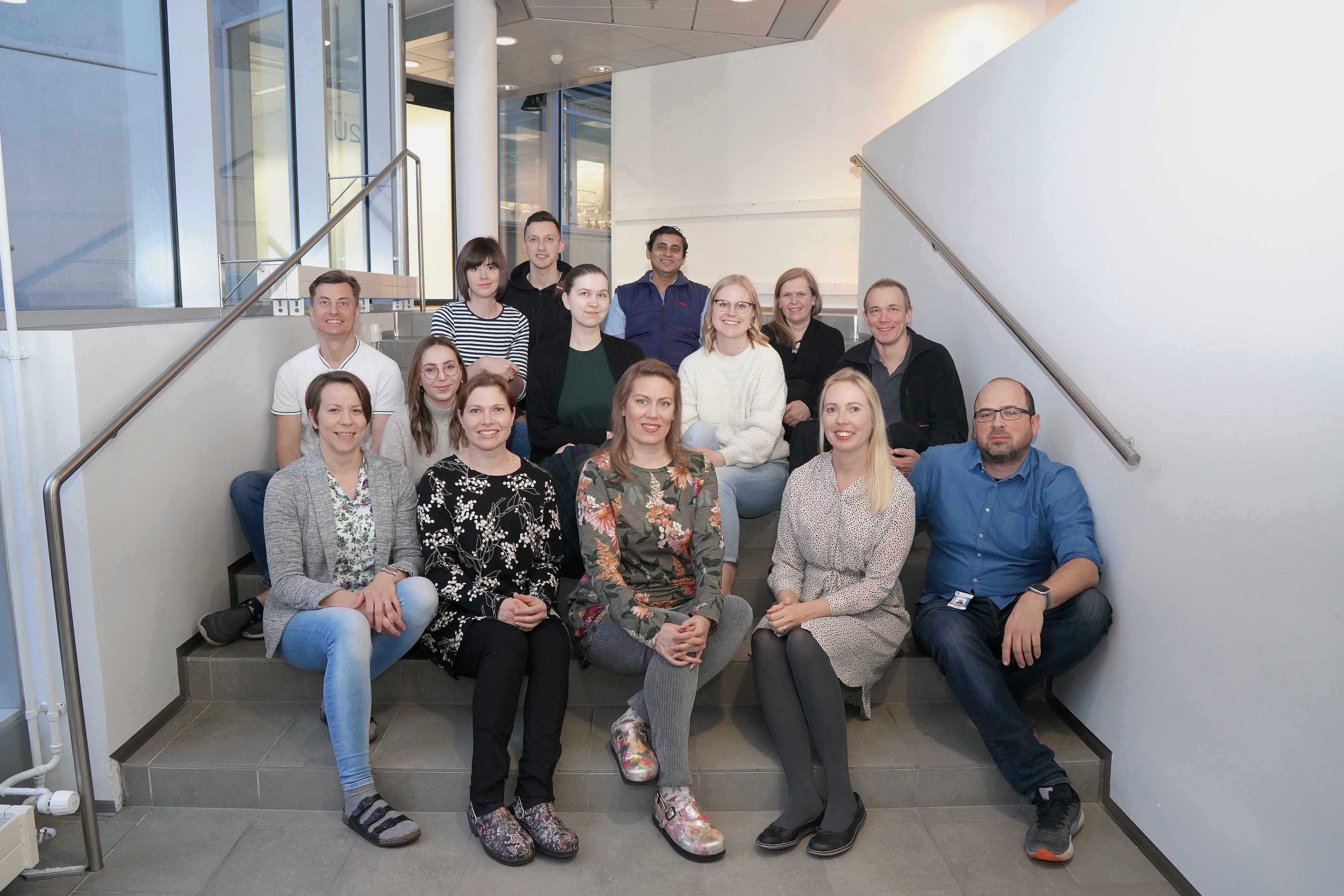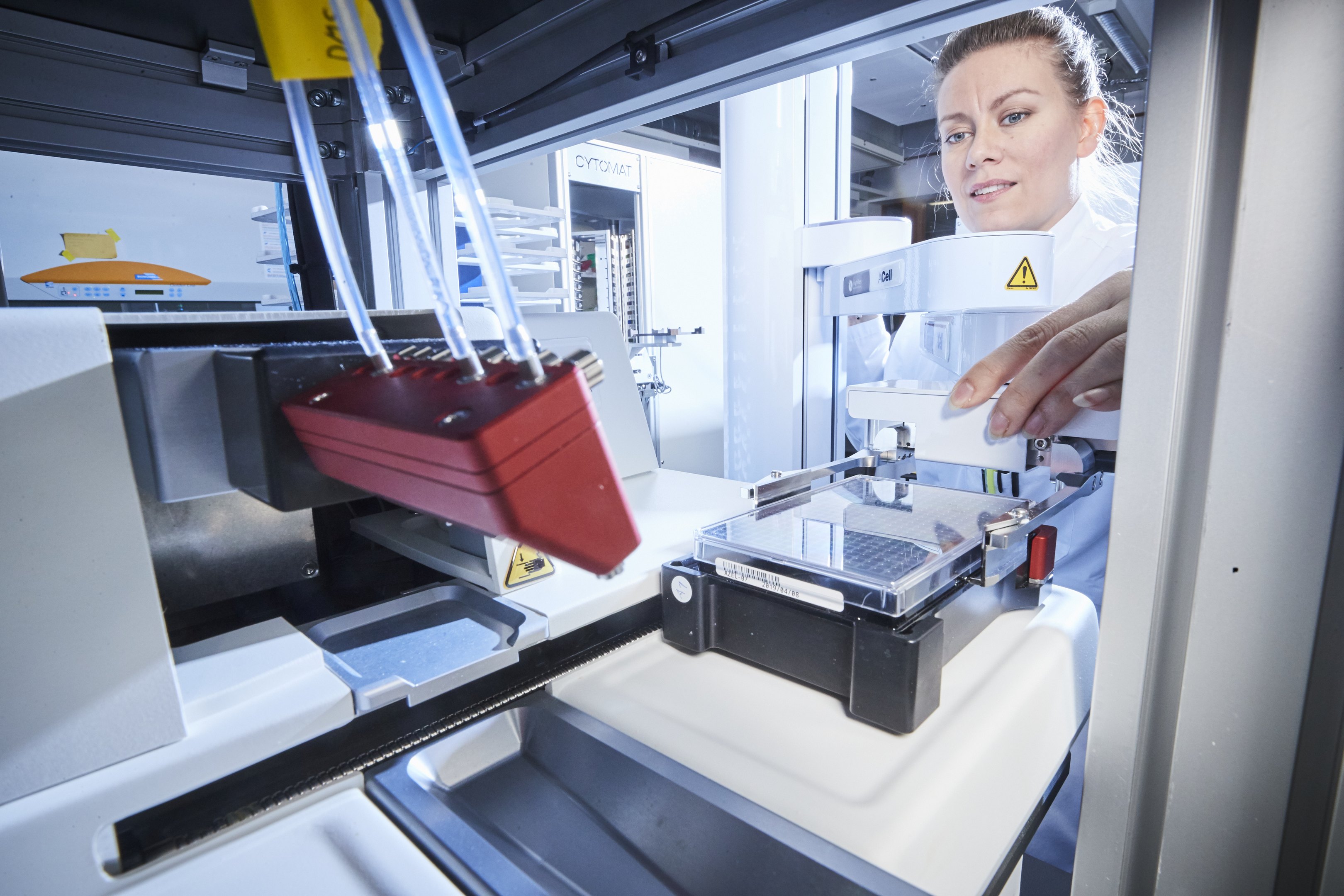Professional high throughput screening for biomedicine
The High Throughput Biomedicine Unit at FIMM: Meet Laura Turunen and Jani Saarela, and learn how the unit is ready to help you answer your research questions


Precision in biomedicine and biomedical research may be more critical than ever before. Advancing personalized healthcare is one of the grand research challenges at the Institute for Molecular Medicine Finland (FIMM), the Finnish node of the Nordic EMBL Partnership for Molecular Medicine.
More broadly, high-throughput screening technologies are essential in realizing the benefits of functional precision medicine and life science research.
FIMM's High Throughput Biomedicine (HTB) core service Unit enables this work by providing services and expertise in lab automation, cell-based and biochemical high-throughput screening, and access to chemical and siRNA libraries and data analysis for local, national, and international users.
Dr. Jani Saarela, Operational Manager of the unit, explains:
We aim to help all users with their specific needs. The HTB Unit has been operating for over 12 years with a dedicated staff of lab coordinators, bioinformaticians, and senior researchers. We are flexible and can operate at high, medium, or low throughput. Regardless of the assay, we want to help.
The HTB Unit offers a wide variety of professional screening services. Examples of the services are Drug Sensitivity and Resistance Testing (DSRT) for doctors and researchers to test pharmacological dependencies of cancer cells, high throughput flow cytometry, high throughput chemical screening, assay-ready drug plates, functional genomics screening, assay miniaturization and multiplexing, and mycoplasma contamination testing.
"In addition to our popular DSRT platform, we also have developed an ELISA for COVID-19 testing, immunofluorescence assays with imaging readouts, Alpha screening, various biochemical assays, and much more.," informs Ms. Turunen.
"Automation is important," adds Ms. Turunen. "We provide access to automation-aided screening, removing much of the variability you get with manual pipetting. For example, we use acoustic dispensing to transfer compounds to assay plates, which allows layout and content customization of assay plates."
In addition, many of the HTB's academic and industry clients are interested in access to biobank samples, and while that's not a direct HTB service, they can help to establish connections.
Drug Sensitivity and Resistance Testing: a popular service at the HTB Unit
Researchers using the HTB Unit often search for bioactive molecules that their cell model system or primary cells are sensitive or resistant to, a collection of functional assays termed DSRT - drug sensitivity and resistance testing. Dr. Saarela explains:
DSRT has been the most popular service requested from HTB for several years. It is an assay that tests the effects of compounds on primary cells or cell lines. Results are typically available within four days of obtaining the sample. We perform DSRT using plate readers, imaging, and flow cytometric readouts. We also send the DSRT assay plates overseas for use in clients' labs.
He continues:
We have pre-designed DSRT drug sets for general oncology, acute myeloid leukemia, multiple myeloma, and solid tumor research. Flow cytometry drug and antibody panels exist for AML, ALL, and multiple myeloma, and custom plates and combinations of compounds are also available.
Ms. Turunen adds, “A new interest in custom compound collections has also come up lately. We are flexible in the format. We have investigational compounds in the hundreds now. And, if the user has their own compounds, we can include those in a screening setup, too.”
With DSRT, it is essential to distinguish between cell proliferation, cell death, and cytostatic effects. Dr. Saarela explains, "we combine a metabolic readout of cell viability (luminescence) with a call toxicity readout (fluorescence) so that from the same sample, we can tease apart effects on each and where a compound might be most active."
These readouts produce manageable and meaningful data. But, the unit goes further for those projects that need deeper information about cell morphology or specific cellular markers by using bioimaging or flow cytometric analyses. The unit provides support for these projects along with the FIMM High Content Analysis unit or dedicated personnel with expertise in antibody panel optimization for flow cytometry. The bottleneck can be the high amounts of data produced, even though the screening throughput is lower than with the metabolic readouts.
DSRT has also been applied to search for synergy and drug interactions, an approach of increasing interest and leading to discoveries such as a treatment for human T-cell acute lymphoblastic leukemia (T-ALL) with temsirolimus and dasatinib and novel synergistic combinations against severe acute respiratory syndrome coronavirus 2 (SARS-CoV-2), echovirus 1 (EV1), hepatitis C virus (HCV) and human immunodeficiency virus 1 (HIV-1) in vitro.
Acoustic dispensing: Achieving high precision for a wide array of services
The second most popular service from the HTB Unit is the preparation of "assay-ready" multiwell plates prepared with high precision. This is done with acoustic dispensing of reagents allowing the team to design the assay plates as the users wish. Ms. Turunen explains:
We can dispense from any well to any well to obtain assay plates with compounds and controls in the requested concentrations in any order. This flexibility and easy scale-up of plate production make this approach very attractive to users. And, very accurate. We dispense 2.5 nl with less than 5% CV (coefficient of variation), far exceeding manual pipetting with 10-20% CV. The correlation is excellent if you repeat an experiment on two different days with two different plates prepared in the same way by acoustic dispensing. Typically 0.9 or better reproducibility, emphasizes Ms. Turunen.
A path to research technology led to teamwork to save lives
Dr. Saarela and Ms. Turunen are dedicated team members at the HTB Unit. Both have been with the unit for over ten years.
Ms. Turunen inclines technology and engineering: "I have always loved molecules, devices, and technologies. I must have been born with some engineering genes that have come to life later in my life. And at FIMM, I am a master of automation."
Dr. Saarela joined the HTB Unit after two postdoc periods without experience in lab automation or high throughput screening. He learned these skills while working on various projects at HTB. He explains: "I remember seeing the HTB equipment when I interviewed. I thought that it was like science fiction. Things started with an excellent high school biology teacher, which led me to think I could go to the university to study biology."
But, it was always patients that were on Dr. Saarela's mind: "And then I always wanted to do something to help patients while doing basic research, and that was not always so easy to achieve. But here, with the functional precision medicine program, I have had that strong translational connection, which has been rewarding."
The HTB team is 14 strong - experienced, international, and enthusiastic.
Dr. Saarela explains one of the key strengths of the team: "The multicultural aspect improves our creativity. We have varied tasks and personalities, but we still work efficiently together. I like that we also have fun."
Ms. Turunen explains why the team works so well together:
We're following some practices that have been around since the beginning. We don't have any hierarchy. Everyone is encouraged to tell what they want to do and focus on their interests. We're trying to get the best out of everyone. I think that takes us a long way. And we are making decisions together.
Dr. Saarela agrees, "I think at the moment, we have good roles for everyone in the team. We talked to them initially about what they would like to do, and then we tried to match the unit's needs with those interests. We then support each other whenever there is help needed."
And the team's most significant accomplishment so far?
"Saving lives," says Ms. Turunen. "By setting up the DSRT platform, libraries, and screening technologies. In the future, I believe that functional precision medicine will be accepted by the authorities and the healthcare system as a way to help the patients, to help find actionable tracks across larger sample sets," expands Dr. Saarela.
Ms. Turunen reflects:
Sometimes we read in the news that we saved a life. That has already happened twice. We didn't know about it before reading it in the newspaper. Still, we find out later because it may have been written in the article that the 'comprehensive oncology collection' was used. And we know that's us.
High throughput biology for your research project
The High Throughput Biomedicine (HTB) Unit of the FIMM Technology Centre at the University of Helsinki offers screening of approved and investigational drugs and other biomolecules. The facility provides support for various assay types, e.g., drug sensitivity and resistance testing, cell-based and biochemical assays, probe discovery, biological profiling, etc., as well as access to screening libraries and data analysis pipelines.
Lab Coordinator Laura Turunen and Operational Manager Dr. Jani Saarela provide their expertise for project consultation and manage the instrumentation along with the rest of the HTB team. The unit is known for its high quality and professionalism. In fact, some companies are seeking to have the HTB Unit certified as an official screening site. The unit is supported by infrastructure funding from Biocenter Finland, the Academy of Finland, and user fees. It is a member of EU-OPENSCREEN, the not-for-profit research infrastructure integrating high-capacity screening platforms in Europe.
Researchers interested in exploring the possibilities of high throughput screening for their projects can contact them directly by email to visit the lab.
Dr. Saarela explains:
We have a low threshold to contact us. Just reach out, and say, 'hey, I'm interested,' and you'll have our attention. If the timing is right, we can also take longer-term visitors who spend a few weeks to a month or two to learn specific assays. It's often part of a research collaboration.
"Most academic projects that come to us are set up as collaborations, but our pricing principles for academic researchers are the same regardless of collaboration or not," emphasizes Ms. Turunen.
Mobility funding from a NordForsk Infrastructure Hub grant may help cover costs for visits to the facility for researchers affiliated with Nordic EMBL Partnership institutes. Please contact your local administration for more information.
The "Technologies Advancing Molecular Medicine" series highlights the people and activities in research technologies and core facilities in the Nordic EMBL Partnership for Molecular Medicine.